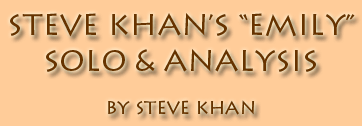

|
Soundclip:
|
| See Steve's Hand-Written Solo
Transcription |
|
Steve Khan's solo on: "Emily"(Johnny Mandel-Johnny Mercer) Since I recorded Thelonious Monk's "I Mean You" on "BORROWED TIME" in 2007, and for each of the albums that followed, I have tried to always include a unique take on the Afro-Cuban 6/8 feeling, which is integral to almost any Latin Jazz recording. On "PARTING SHOT"(2011), "María Mulambo"(Khan-Badrena) filled that role, and Wayne Shorter's "Infant Eyes" from "SUBTEXT" served the same purpose. 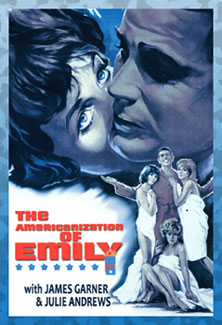 As I was preparing to record "BACKLOG," and searching for the material that I wanted to interpret, once again, the question arose as to what could I now do to offer something new and different to the wondrous mysteries of the Afro-Cuban 6/8. Somewhere along the way, my thoughts drifted towards my memories of, and great affection for Johnny Mandel and Johnny Mercer's strikingly beautiful ballad in 3/4, "Emily," that comes from the 1964 film, "THE AMERICANIZATION OF EMILY" and starred Julie Andrews and James Garner. This seemed like a great idea to me, but the question became, could we play it in 6/8, with all the traditional Latin percussion sounds, and still retain the elegance and beauty of the Jazz ballad format? Using the modern technologies of Pro Tools, I assembled a demo, and I was very pleased with the feeling that I had created, but I had to submit what I had done to Marc Quiñones, my trusted rhythmic captain, to make certain that he would have no problems with my trying to do something like this. Lucky for me, Marc gave me the "go ahead" sign, and it then seemed as though I just had to finalize certain aspects of the arrangement. As I was preparing to record "BACKLOG," and searching for the material that I wanted to interpret, once again, the question arose as to what could I now do to offer something new and different to the wondrous mysteries of the Afro-Cuban 6/8. Somewhere along the way, my thoughts drifted towards my memories of, and great affection for Johnny Mandel and Johnny Mercer's strikingly beautiful ballad in 3/4, "Emily," that comes from the 1964 film, "THE AMERICANIZATION OF EMILY" and starred Julie Andrews and James Garner. This seemed like a great idea to me, but the question became, could we play it in 6/8, with all the traditional Latin percussion sounds, and still retain the elegance and beauty of the Jazz ballad format? Using the modern technologies of Pro Tools, I assembled a demo, and I was very pleased with the feeling that I had created, but I had to submit what I had done to Marc Quiñones, my trusted rhythmic captain, to make certain that he would have no problems with my trying to do something like this. Lucky for me, Marc gave me the "go ahead" sign, and it then seemed as though I just had to finalize certain aspects of the arrangement.Rhythmically speaking, Marc(timbal), Bobby Allende(conga), and Rubén Rodríguez(Baby Bass) would all operate from within variations on the Afro-Cuban 6/8, but I was going to be asking drummer Mark Walker to approach the piece on brushes with a different twist to it. As my own preparations on the guitar began to develop, I realized that I was playing over the 6/8, but with a slightly swingy 4/4 Jazz feeling. So, I wanted Mark Walker to be on that side of the rhythm with me. We would be playing in that world over what Marc, Bobby, and Rubén were doing. In my heart, I knew that it could work. I think that the biggest consideration for me had to be, what key would feel and lay the best on the guitar? There are really four interpretations of "Emily" that resonate deeply with me, and each one for a different set of reasons. Where vocals are concerned, of course, I love the Frank Sinatra version, performed in B major, but I have always been most partial to the Tony Bennett version from "THE MOVIE SONG ALBUM," which he sings in D major. How rich and warm those sharp keys sound. Instrumentally, how could I ever forget Bill Evans playing the song, in the key of C major, on his "FURTHER CONVERSATIONS WITH MYSELF" album from 1967. But, the version that I always seem to drift back to is by Paul Desmond from his 1968 album, "SUMMERTIME," performed in Eb major, which featured the brilliant piano of Herbie Hancock. As you can see, four great artists, four different keys. But, for me, I eventually settled on the key of Bb major, because I felt that it put me in the warmest register of the guitar. Sitting here now, I have no recollection as to exactly how much time I spent in crafting the arrangement for this song, but I am certain that I labored long and hard to come-up with some kind a unique introduction to the piece, and finally, after lots of trial and error, it came to me, and on the guitar, not on the keyboard. I wanted to use the basic intervals of the melodic name "Em-i-ly" but reharmonized, and then adorned with light orchestra bells to bring out those pitches. For the [I] section and the closing [TAG], on my demo, I used some eerie sounds that I found within the Xpand2 library. For the body of the piece, I wanted to have a very lush string background, and so, of course, once again, I looked deep into all of my Clare Fischer harmonic vocabulary, and created a basic texture for the all the sections that would utilize the strings. As is always my work process, I eventually submit what I have done as midi files to the great Rob Mounsey, and my simple request is that he would assign better sounds to what I had done. I don't ever want to push the bounds of friendship too far. Most times, I never know what Rob is going to send back to me, but usually, even if it is something quite simple, it is always beautiful, and just what I was hoping for. But this time, just as it was for "Our Town," Rob simply outdid himself, and wrote a full-blown arrangement, counterpoint and everything, on top of what I had laid out. The first time I listened to what he had sent back to me, I had tears in my eyes again. 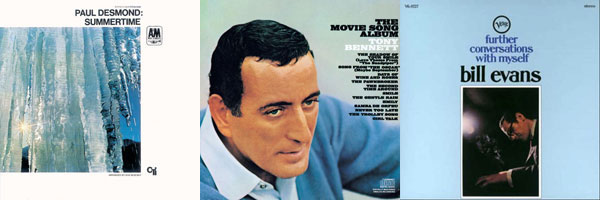 Our "Emily" was everything that I had dreamed that it could be! Rob chose to color the [I] and [TAG] sections with a texture of flute sounds, which are also spectacular and mysterious as well. Our "Emily" was everything that I had dreamed that it could be! Rob chose to color the [I] and [TAG] sections with a texture of flute sounds, which are also spectacular and mysterious as well.As I began to consider the form and structure that the arrangement would follow, I felt that, after a full chorus of soloing, a modulation would be a wonderful touch to add for a 1/2-chorus. At first, and for quite some time, I was pleased with the modulation that I had created, which took me to Db major. But, the more that I lived with it, the more I was troubled by the fact that, at bar 9 of that section, it would take me right back to Bb major, and that began to feel too redundant for me. So, it was back to the drawing board, and finally, after much thought, soul searching, and trial and error, I arrived at a modulation to E major. This felt great to me, because at that same bar 9, it took me to Db major, and finally the section resonated in a far better way. It made the transition of going back to Bb major for the final statement of [A2] seem all the more wonderful. And so, with that done, everything was now in readiness for the recording. On any recording, on any particular song, no matter what the tempo or feeling might be, my goal is to create a work of beauty, grace, and dignity, while always being within the flow of the music that is being performed on that given day. One must always aspire to the highest artistic aesthetic possible. All other earthly considerations are rendered meaningless. When I moved to New York in 1970, it wasn't long before I encountered two great, great musicians, who became good friends and colleagues throughout all of these long years. Those two players were John Abercrombie and Ralph Towner. Even at that time, both of them had a sense of knowing exactly what great music, and great music-making was all about, and it was obvious to me that then, they were both closer to that higher aesthetic than I could be at that moment in time. When one considers that in 1977, I was recording "TIGHTROPE," my first album as a leader, but Ralph had already recorded, "SOLSTICE," and John had recorded "TIMELESS"! The spirit and the depth of those two recordings is overwhelming in comparison - if one can or should do such things. Over the years, both John and Ralph have said or written any number of things about music, and music-making that have resonated deeply with me, because those quotes represent a meaningful expression of exactly what I feel and strive to do as well. The other day, because I just love his solo guitar work, I bought Ralph's recent release, "MY FOOLISH HEART"(ECM), and once again I was very moved to read what Ralph had written on the opening page of the CD booklet. If I may, I would like to share that with you here.
Prior to the beginning of the solo at [B], there is a little harmonic touch in the turnaround pick-up bars. With so much hard work going into this arrangement, I did not want to have a standard ii-V in the bar before the solo, so I decided to use an option that I have always liked, and that is to employ the iv chord, in this case Ebm7, and use its ii-V, so that it becomes Ebm7(sus) to C/Ab, instead of the expected Ab7(13). The pick-up line puts to use notes from Eb Dorian [Eb, F, Gb, Ab, Bb, C, Db], and on beat 4, you have an Ab augmented triad, if you forgive me for spelling Ab as G#. As the solo proper begins, keep in mind that, I was just trying to play things that were melodic and simple, where there would be a continuity from phrase to phrase. The 1st 4 bars with a I-vi-ii-V, offer the easiest opportunity to be as melodic as one could be, if one chose to be so, playing completely diatonically in Bb major. This holds true until you hear the Gb(b9) note on beat 1 of bar 4. In bar 2, you see a triplet grouping of D-C#-D, and this is going to become a thematic device that appears throughout the solo, where you will have a consonant note, and then its chromatic lower neighbor and back. After going through the entire solo, that very inconspicuous fragment appears 16 times in all. It is also crucial to note that, after having been supported by Rob's beautiful strings and harps throughout the statement of the melody, as the solo section begins, the texture completely thins out, and you could say that we now have a guitar trio with Latin percussion. This kind of open and transparent texture is what I have become accustomed to, and enjoy the most. Notice how beautifully Mark Walker's brushwork dances in and out of the 6/8 rhythms as performed by Marc and Bobby, all anchored by Rubén's baby bass. In bars 5-8, we have another chord progression that is a huge part of what makes the song "Emily" so wonderful. In bar 6, over the Bb7(9sus) chord, I am essentially playing two triads, an Ab triad that gives me the richness of the consonant color tones, and then a G triad, which brings in the b9(B-natural) as we cadence to Ebmaj7. 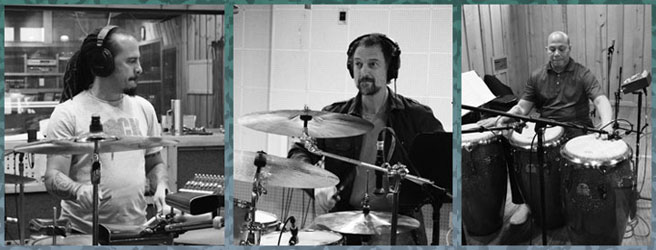 Over the Ab7(9b5) chord in bar 9, you could say that I am putting to use Eb melodic minor [Eb, F, Gb, Ab, Bb, C, D], which gives us the b5(D-natural) relative to Ab7. Over the Ab7(9b5) chord in bar 9, you could say that I am putting to use Eb melodic minor [Eb, F, Gb, Ab, Bb, C, D], which gives us the b5(D-natural) relative to Ab7.Then, in bar 9, another one of the great compositional touches by Johnny Mandel, as we modulate briefly to G major for another I-vi-ii-V. It is during the first 5 bars that we have the only appearance during this solo of my typical chordal punctuations. The harmonic style of these voicings owes a great debt to the way that Chick Corea was playing Latin music on Cal Tjader's classic album from 1966, "SOUL BURST"(Verve). But. in the end, all such stylings come from, in my opinion, McCoy Tyner, and his playing roughly during the entirety of that same decade. During this solo, the chords appear in bars 9 and 11-13. If you think of bars 9-12 as being in the key of G major [G, A, B, C, D, E, F#], all the single note lines that I played were completely diatonic. In bars 13-16, as Mandel's chord progression turns the tune back around to its principal key of Bb major, there are some nice harmonic challenges to negotiate. In bar 13, notice the usage of the F# as a lower neighbor to G-natural over the Gm7 chord. Over the C7 chord, again using the transparency of this texture, I play a Gb triad (Gb-Db-Bb), and use that to end-up on an Eb(#9). I love how this sounds in the open space. Over the Gb7(9b5), where we have the first appearance of a double-time line, I would say that what I played draws from the Db melodic minor scale [Db, Eb, Fb, Gb, Ab, Bb, C] with some chromaticism. In bar 16, over the F7(alt.) chord, I used notes from the B dominant 7th pentatonic [B(b5), C#(#5), D#, F#(b9), A] and, as you can see, doing this gives me 3 of the 4 altered tones, relative to F7. As the [B2] section of the solo begins, the strings re-enter with counterlines supplied by Rob's harps, playing on each dotted quarter-note. Over the I-vi-ii-V, this time there is a new melodic motif through the 1st 3 bars. When the F7(alt.) arrives in bar 4 of the section, the double-time line implies the sense of the ii-V of the bV substitute B7. The sound that I produced comes from using F# Dorian [F#, G#, A, B, C#, D#, E]. In bar 6, over the Bb7(9sus), for the 1st 2 beats, the line comes from F Dorian [F, G, Ab, Bb, C, D, Eb]. But, as I add in the alterations on beats 3-4 to cadence to Ebmaj7, that line is again using a ii-V approach to this bV substitute of E7 [Bm7-E7] over Bb7(alt.). So, with a lot of chromaticism, I am applying B Dorian [B, C#, D, E, F#, G#, A]. Notice how the line nicely dovetails to a Bb, preceded by B-natural, one 1/2-step above. Over the D7(alt.) chord in bar 8 of the section, I am sitting on each quarter note, where I am feeling the time, and using a device that I associate with George Benson, where you have essentially an octave, but with a 3rd below the top voice. It is at this point 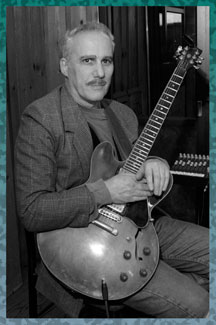 in bar 9 where [B2] takes a most distinct path from the previous 16-bar section. Notice the melodic development continues while observing each chord change. I especially love the chord change from Gm7 to A7(#5). The flow of the lines continues until we arrive at the F7(alt.) chord in bar 14 of the section. Here, I have employed a rather angular line configuration which is really derived from the F 1/2-tone/whole-tone diminished scale [F, Gb, Ab, A, B, C, Db, Eb]. To see the relationships, you might have to enharmonically spell some of the notes. Over the G7(alt.) chord in bar 16 of the section, as if we were headed to cadence on Cm7, I am using the C harmonic minor [C, D, Eb, F, G, Ab, B]. This is a very common linear device amongst Jazz players when cadencing to a minor chord.
in bar 9 where [B2] takes a most distinct path from the previous 16-bar section. Notice the melodic development continues while observing each chord change. I especially love the chord change from Gm7 to A7(#5). The flow of the lines continues until we arrive at the F7(alt.) chord in bar 14 of the section. Here, I have employed a rather angular line configuration which is really derived from the F 1/2-tone/whole-tone diminished scale [F, Gb, Ab, A, B, C, Db, Eb]. To see the relationships, you might have to enharmonically spell some of the notes. Over the G7(alt.) chord in bar 16 of the section, as if we were headed to cadence on Cm7, I am using the C harmonic minor [C, D, Eb, F, G, Ab, B]. This is a very common linear device amongst Jazz players when cadencing to a minor chord.The final 8 bars of "Emily," at least as I have chosen to treat it, puts to use a combination of chord changes that I loved from both Don Sebesky's arrangement for Paul Desmond, and Johnny Mandel's arrangement for Tony Bennett. When one knows and understands the lyrics, this becomes the emotional pay-off to the song. This felt like the moment for some double-time lines to appear. In bar 17, over the Em7b5 chord, I am using G Dorian [G, A, Bb, C, D, E, F] with some chromaticism. And in the following bar, over the Ebm7, I am simply applying Eb Dorian [Eb, F, Gb, Ab, Bb, C, Db]. Notice how I began with the interval of a 6th in bar 17, and then ended the long lines with a 6th again as bar 18 finishes. This was, of course, not thought out at all. Over the G7 chord in bar 20, notice how the b5(C#) is simply used as the lower neighbor to surround the real target note of D-natural. The last 4 bars, bars 21-24, not only give us our final cadence to Bbmaj7, but also our transition in bar 24 for the modulation to E major. In bar 22, over the F7(alt.) chord, I am again playing notes derived from F# Dorian (the ii chord of the b5 sub), with one interesting twist in that here I used a G-natural instead of the expected G#. But here, the natural 9th is O.K., because we are headed towards a major chord. Over the Bbmaj7 chord, I am playing D minor pentatonic [D, F, G, A, C]. To make the transition to the key of E major, I decided to use a chord progression where the bass notes descend chromatically: Gbmaj7(9) to F7(#9) and then finally to Emaj7(9). Over the brief, 2 beats on the Gbmaj7 chord, I am playing Bb minor pentatonic [Bb, Db, Eb, F, Ab]. And finally, over the F7(alt.) chord, remember that we are headed to Emaj7, and not Bbmaj7, you could say that on beat 3, I am using a portion of the F altered dominant scale [F, Gb, Ab, A, B, C#, Eb], which is the same a Gb melodic minor [Gb, Ab, Bbb, Cb, Db, Eb, F]. But, on the 4th beat, you can see that I descended through a B7 chord, using all the notes except the root. We then cadence perfectly on a B-natural, the 5th of Emaj7(9) as the new section of [C] begins. As we have arrived at the key of E major, it is striking how the change to a sharp key from a flat key seems to, for the moment, lighten things up a bit. There have been some fascinating books written about the psychology of music, and the impact on the emotions of harmony. It is far more deep than the often used phrases for children like: "Major is happy, and minor is sad!" This sounds pretty amusing even as I write it here. 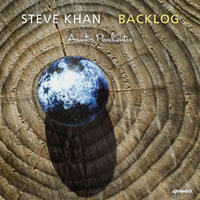 Anyway, with the change in harmony, I seemed to drift back to paraphrases of our main thematic element, the name Emily is put to use through the I-vi-ii-V in the new key. Notice how, in bar 4, over the B7 chord, the b5(F-natural) is touched upon briefly in between two consonant notes: F# and A-natural, and its presence almost makes the A-natural sound as though it is the more interesting note. As the lines descend in a most melodic way through bars 5-8, the usage of the lower register of the guitar appears, and there is a nice moment in bar 7, where I played a low C# on the A-string up to E-natural over the Amaj7(9). I remember the 1st time that Rob heard this go by during a post-production meeting, he smiled at me, and gave me a warm nod of approval. Needless to say, that felt pretty great. In bars 9-12, as the lines flow on, one phrase connected to the next, there is another moment where the interval of a 6th plays a key role. That happens in bar 12 over the Ab7(b9b5) chord, as you have F-natural going down to A-natural, which is the b9 of the chord. The final 4 bars, generally speaking, are both Dorian areas: Dbm7-Gb7 followed by Cm7-F7. In bar 14, the double-time line is from Db Dorian [Db, Eb, Fb, Gb, Ab, Bb, Cb] with some chromaticism. And finally, over the F7(alt.) chord in bar 16, the final cadence to return to the melody, and again I am putting to use the F 1/2-tone/whole-tone diminished scale as the line gracefully flows right into a D-natural on beat 1 and the final statement of this gorgeous melody. Anyway, with the change in harmony, I seemed to drift back to paraphrases of our main thematic element, the name Emily is put to use through the I-vi-ii-V in the new key. Notice how, in bar 4, over the B7 chord, the b5(F-natural) is touched upon briefly in between two consonant notes: F# and A-natural, and its presence almost makes the A-natural sound as though it is the more interesting note. As the lines descend in a most melodic way through bars 5-8, the usage of the lower register of the guitar appears, and there is a nice moment in bar 7, where I played a low C# on the A-string up to E-natural over the Amaj7(9). I remember the 1st time that Rob heard this go by during a post-production meeting, he smiled at me, and gave me a warm nod of approval. Needless to say, that felt pretty great. In bars 9-12, as the lines flow on, one phrase connected to the next, there is another moment where the interval of a 6th plays a key role. That happens in bar 12 over the Ab7(b9b5) chord, as you have F-natural going down to A-natural, which is the b9 of the chord. The final 4 bars, generally speaking, are both Dorian areas: Dbm7-Gb7 followed by Cm7-F7. In bar 14, the double-time line is from Db Dorian [Db, Eb, Fb, Gb, Ab, Bb, Cb] with some chromaticism. And finally, over the F7(alt.) chord in bar 16, the final cadence to return to the melody, and again I am putting to use the F 1/2-tone/whole-tone diminished scale as the line gracefully flows right into a D-natural on beat 1 and the final statement of this gorgeous melody.As this analysis began, I tried to explain how I was hearing my melodic role on "Emily" as one where I would be playing 4/4 and floating over the 6/8 groove. In my experience, especially in various areas of Latin music, I have come to feel that there is no group of musicians who move more effortlessly and gracefully between 6/8 and 4/4 or "big 3" and 4/4 as Latinos. They are simply incredible at this, and I've learned so much from playing with them. Where playing with a slight swing feel is concerned, for me, that idea comes from one familiar recording, and that is Cal Tjader's 1966 "SOUL BURST"(Verve) album. The influence of that album, the music within it, and the incredible performances on piano of a young Chick Corea just changed my life. On that same album, on the tune, "Curaçao" there was a moment that struck me immediately the first time that I heard it go buy, and it stayed with me. It entered into my growing awareness of the possible in music. At somewhere around the 4:40 mark of this great tune in 6/8, Chick goes into a really forceful swing feel over the 6/8, and then, just as gracefully, he exits that feeling and returns to playing in the hypnotic 6/8. In truth, my own capacity to feel that, and play that way comes from what I heard way back when. Even with the 6/8 going on from Marc, Bobby, and Rubén, the feeling that I hear enables me to lightly snap my fingers on 2 & 4 as if the music was in a swing 4 feel and not 6/8 at all. If you can hear that, and feel it too, then you've got it. As I have previously stated, my friendship and musical association with Rob Mounsey now spans some 40 years. It is hard to believe, sitting on this end of the time spectrum, that it has actually been that long. We have contributed to each other's projects, and made two wonderful recordings together as well: "LOCAL COLOR"(1987) and "YOU ARE HERE"(1998). 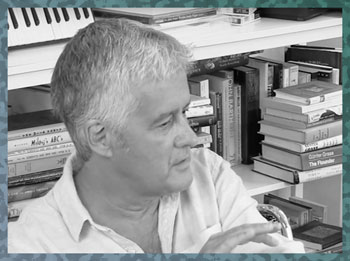 I treasure both of them. Rob's contributions to my recent recordings, beginning in 2005 with "THE GREEN FIELD" have been immense. In the end, I could not have done any of them without his help, guidance, voice of sanity, and supreme musicality. On "BACKLOG," the increased importance of Rob's orchestrations and arrangements on both "Our Town" and "Emily," became a huge part of the emotional impact of this album. Now that I have posted what I had originally laid out as my contribution to the arrangement for "Our Town," it only seems logical that I would now post the KEYBOARD LEAD SHEETS for "Emily" as well. So, for those of you who might be interested in such things, you can actually see what I wrote out for Rob, and then, while you are listening, you can hear the artistry, and sense of great romance that he added above and beyond to make this into a full and rich listening experience. One that I still find exceptionally emotional and moving. It is interesting. at least to me, that in bar 12 of [A2] we play the chord as G7(9), but, when that same bar appears during the solo section, [B2], it is played as Gm7(9). Now, how that happened, I honestly don't know, but I do know that it is something that Rob and I never discussed, so when it went by, I just reacted to the sonority that I heard, and wasn't thinking about what I had mapped out originally. I treasure both of them. Rob's contributions to my recent recordings, beginning in 2005 with "THE GREEN FIELD" have been immense. In the end, I could not have done any of them without his help, guidance, voice of sanity, and supreme musicality. On "BACKLOG," the increased importance of Rob's orchestrations and arrangements on both "Our Town" and "Emily," became a huge part of the emotional impact of this album. Now that I have posted what I had originally laid out as my contribution to the arrangement for "Our Town," it only seems logical that I would now post the KEYBOARD LEAD SHEETS for "Emily" as well. So, for those of you who might be interested in such things, you can actually see what I wrote out for Rob, and then, while you are listening, you can hear the artistry, and sense of great romance that he added above and beyond to make this into a full and rich listening experience. One that I still find exceptionally emotional and moving. It is interesting. at least to me, that in bar 12 of [A2] we play the chord as G7(9), but, when that same bar appears during the solo section, [B2], it is played as Gm7(9). Now, how that happened, I honestly don't know, but I do know that it is something that Rob and I never discussed, so when it went by, I just reacted to the sonority that I heard, and wasn't thinking about what I had mapped out originally.One other touch to the sonic palette of my recordings that is really important to me is the sound of a rivet cymbal, especially on a ballad. Over the many long years, I have actually been collecting them and have two cymbal bags that only contain rivet cymbals, but within those bags I have 3 favorites. Of course, for drummers and timbaleros alike, a cymbal is a highly personal thing, and one has to be very careful when asking them if they wouldn't mind incorporating one or two of my cymbals into their set-up for a tune or two. In general, I've been really fortunate with this as most drummers recognize that my cymbals really sound fantastic. Both of my favorites for the drums came to me as gifts from drummer Danny Gottlieb, who used to have a storage locker full of cymbals. Lucky for me, he gave me two Paiste 602 Flat Rides. They are: [1] a 20" Heavy Flat Ride which has 3 rivets in it, and [2] an 18" Thin Flat Ride with 2 rivets in it. On both "Our Town" and "Emily," Mark Walker added these cymbals to his set-up with the 20" on the right side, and the 18" on the left side. During the performance, you mostly hear the 20" on the right. The sound of rivets ringing through everything is, for me, one of the most musical sounds that I can imagine. It actually helps me to play less, because a certain sonic space gets filled by the sound of the rivets. I started bringing them with me, especially to recordings, because so many young drummers didn't have a rivet cymbals, or, if they did, they were only using that chain that gets draped across the cymbal - but for me, this is, in no way, the same thing!!! Not at all!!! For me, when playing a ballad, especially the melody, I always want to be playing it, expressing it, from the perspective of knowing the lyrics, and hearing them in my imagination, even if only instrumental notes are being played. I always want to be in touch with what the song means to me. As I wrote in the CD booklet for "BACKLOG," I wanted this performance to reflect my love and admiration for the way that both Paul Desmond and Jim Hall approached playing melodies, and then soloing in a most melodic and developmental fashion thereafter. In the end, the goal was to create a work of lasting beauty, and I am going to hope that to many, we achieved that. As I close here now, I leave you with Johnny Mercer's lyrics to the final moments of "Emily" as sung. Two lovers alone and out of sight Seeing images in the firelight As my eyes visualize a family They see Emily, Emily Too If, before closing out here, I could return to Ralph Towner one last time, I want to share one last little story that has so much meaning for me. In 1980, I recorded "EVIDENCE"(Arista/Novus), which, as it turns was released in the same year as Ralph's brilliant "SOLO CONCERT"(ECM) album. 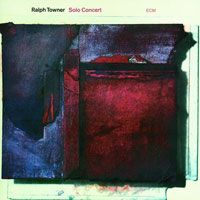 I see his album as a true landmark in using the acoustic guitar: classical and 12-string as if each one was its own orchestra. I still enjoy listening to these performances. Somewhere during the next year or two, I remember running into Ralph somewhere, and he proceeded to tell me just wonderful and unique he felt that "EVIDENCE" was to him. I can't recall the exact superlatives that he used, but, high-level compliments coming from him just meant the world to me, especially in a moment that was, generally speaking, one of the darker periods in my career. I will simply never forget that Ralph thought so highly of that piece of work. I see his album as a true landmark in using the acoustic guitar: classical and 12-string as if each one was its own orchestra. I still enjoy listening to these performances. Somewhere during the next year or two, I remember running into Ralph somewhere, and he proceeded to tell me just wonderful and unique he felt that "EVIDENCE" was to him. I can't recall the exact superlatives that he used, but, high-level compliments coming from him just meant the world to me, especially in a moment that was, generally speaking, one of the darker periods in my career. I will simply never forget that Ralph thought so highly of that piece of work.In the years that have followed Ralph has released several fantastic solo guitar albums. These would include: "ANA"(1997); "ANTHEM"(2001); "TIME LINE"(2006) and most recently, "MY FOOLISH HEART"(2017). It's hard to forget the solo guitar pieces that are included in "OPEN LETTER"(1991). In short, Ralph is simply a great artist and I very much value his body of work, and his friendship. His high aesthetic ideals inform the things that I try do.
[Photo Collage: Marc Quiñones, Mark Walker and Bobby Allende @ Avatar Studios by Adela Blanco
Photo: Steve @ Avatar Studios by Richard Laird Photo: Rob Mounsey @ Home Studio during an interview for Michael Davis' Bone2Pick Series] |